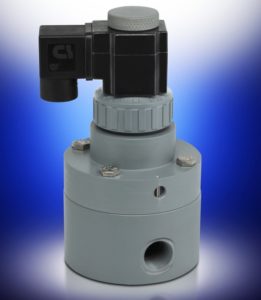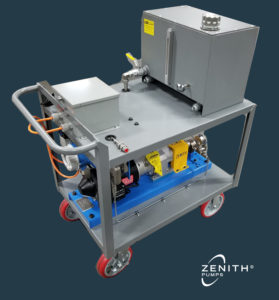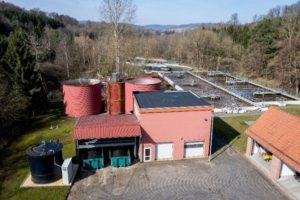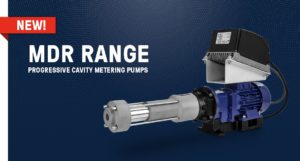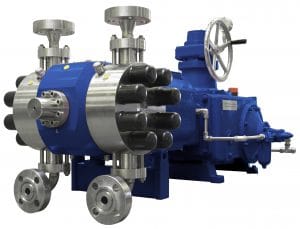Lewa Supplies New Touchscreen Control for Odorizing Systems
In nearly all countries, continuous, proportional odorizing and monitoring is mandated by law for potentially hazardous or highly explosive gases with no natural odor. Lewa has developed a new Odor Control Unit (OCU) in order to fulfill this need efficiently and without requiring a major commitment of time and personnel.
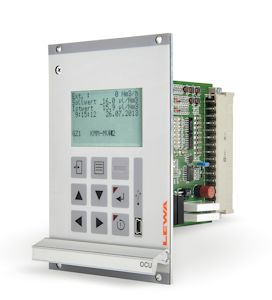
The fully automated OCU odorizing controller continuously compares the target and actual level of the odorant concentration. It is available in 19" assembly racks or in the CC7000 wall-mounted housing. (Image: Lewa)
The system continuously compares the target and actual concentration of the odorant, so that regular inspections of the odorizing systems can be discontinued within four weeks, or occur only at longer intervals. A touchscreen version of the control unit will be exhibited at this year s GAT in conjunction with a Lewa OD60 odorizing system for natural gas, biogas, and liquefied gas, plus an explanatory P&ID flow chart. Visitors to the Lewa booth will also be able to view a version of the OCU controller equipped with an EExd housing (no connected system). Looking to the future, Lewa is also exploring the topic known as Industry 4.0.
Lewa has been delivering the OCU controller for fully automated monitoring and control of odorizing systems since October 2014. The fill level of the odorant tank can now be calculated electronically without a probe and is reset when the tank is filled. A dialog guides the user through the required settings using nine buttons. Several languages are available. The OCU can be optionally ordered with a touch screen. The concentration of odorant is controlled digitally in steps of 0.1 µl/Nm³ and is adjusted in a closed loop. When a disturbance is detected, it is indicated by a red LED and a plain-language notification on the backlit display. Up to 200 error messages can be stored, including date and time. The "internal" mode can be used to simulate a desired volume of gas when the gas meter is defective or for service purposes. Important operating data are be registered as output signals or transferred to the operator s main control unit, e.g. through the LEWA Netportal. This eliminates the need for time-consuming manual stroke adjustment while keeping safety uniformly high.
Modular design – including Ex-protected version
Existing systems from Lewa or other manufacturers can be easily retrofitted with the controller while observing a few requirements. The controller itself consists of one or two SPU power supply units and one OCU control unit for activating one or two magnetically or motor-driven pumps. The controller is modularly constructed of 19" plug-in cards. Depending on the on-site conditions, the controller can be delivered in a 19" assembly rack with integrated motherboard or in a plastic CC 7000 wall-mounted housing according to the IP66 protection class, also with integrated motherboard. A version with an EExd housing like the one exhibited at GAT, certainly without the complete system, is also available. Depending on the customer s requirements, a variety of additional assemblies are available, like for additional inputs or outputs or special functions. For example, the EXU Ex input card is provided as an assembly for digital Ex inputs from KMM, float switches, or similar devices, and has its own front plate with LEDs. Plug and Play expansion assemblies are easily connected through the digital outputs to the SPU or through a BUS.
Odorizing systems with hermetically tight diaphragm metering pumps
A PI&D flowchart of the OD60 will be displayed at GAT in order to visualize interaction between the odorizing system and control unit. Most systems are designed according to specific customer requirements, but always in compliance with national and international regulations. Depending on the conditions of the application, magnetically, pneumatically, or electrically-driven diaphragm metering pumps are used and combined with proven standard components, whereby all wetted parts are produced from corrosion-resistant stainless steel. Odorizing systems are used for many different gases and gas mixtures comprised of natural gas or liquefied gas, biogas, technical gases, even oxygen or nitrogen, and can convey up to 40 l/h at pressures of 2 to 300 bar. These systems are characterized by their hermetic tightness and precision metering in addition to a modular design for high uptime, straightforward and safe operation and maintenance, and overall efficiency.
As in many other areas of industry, the topic known as Industry 4.0 is growing in importance for gas odorization. Lewa is currently intensively exploring options for expanding communication connections to odorizing controllers. "Over the next two years, we will take a good hard look at the available technology so that in the future our odorizing systems can be controlled through an Internet or VPN connection," says Lewa Product Manager Walter Richter. At GAT, he and his colleagues will be ready to talk about first concrete request and discuss specific inquiries for odorizing systems.
Source: LEWA GmbH

